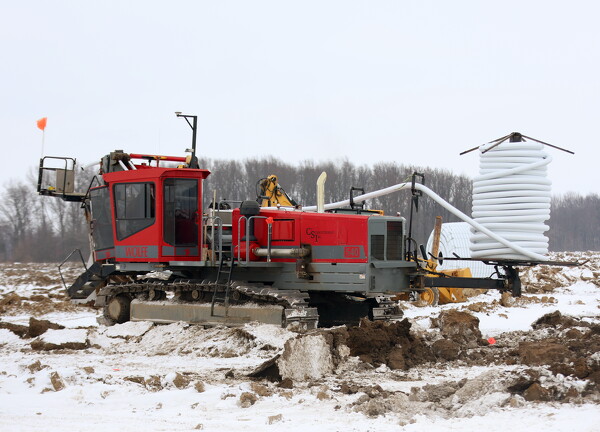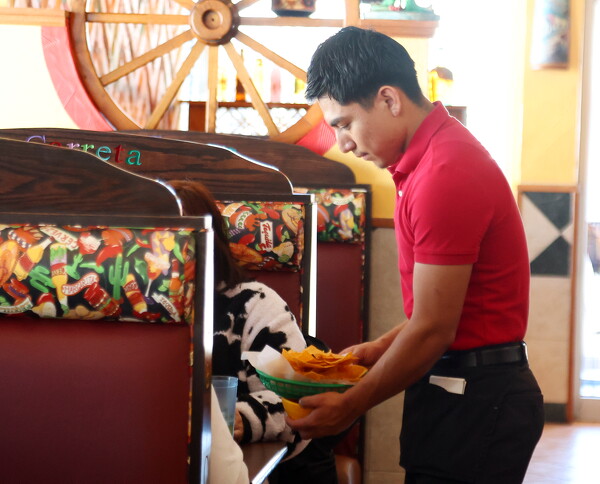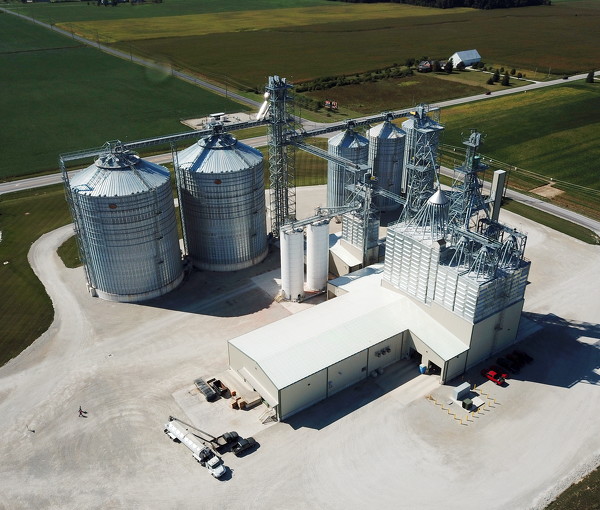
The $26 million MPS Feed Mill is a partnership between Mercer Landmark Inc. and Prairie Star Farms. Today, Mercer Landmark has more than 300 employees and 20-plus locations in Mercer, Darke, Van Wert, Paulding and Defiance counties. The cooperative provides grain, agronomy, feed, energy and logistics services.
CELINA - Since 1933, Mercer Landmark has dedicated itself to helping agricultural producers turn a profit and communities thrive, pooling local resources to achieve better outcomes.
Today, the farmer-cooperative has more than 300 employees and 20-plus locations in Mercer, Darke, Van Wert, Paulding and Defiance counties. Mercer Landmark provides grain, agronomy, feed, energy, and logistics services.
Anyone can sell to and buy from Mercer Landmark, but membership has its perks - and requires a mere $10 purchase of stock. In fact, the cooperative has in excess of 4,000 members who share in the cooperative's profits in the form of patronage and vote on a board of directors, according to president and CEO Heath Barnes, who came to Mercer Landmark by way of the Pacific Northwest.

President and CEO of Mercer Landmark, Heath Barnes.
"I think as a company, one of the things that we really focus on is how do we continue to provide market access for our farmer members," Barnes told The Daily Standard. "One of the pillars that we stand on is really trying to provide market access in all functions. So that comes in the form of procuring crop inputs, to marketing their crop out the other end, to providing feed, to providing rail access - those kinds of things."
Farming cooperatives really started to take off in Ohio around the first quarter of the 20th century to offset the market power of large companies.
"Farmers felt like they were getting taken advantage of, which more than likely, they probably were in those days," Barnes said. "They set out to build facilities collectively themselves so that they could kind of turn that market dynamic on its head and procure some of the leverage back to themselves."
In short, cooperatives have been very successful in leveraging a larger combined footprint, thus reducing costs and increasing profitability for American farmers, according to Mercer Landmark's website. Cooperatives help producers access markets, achieve economies of scale and gain market power through jointly marketing, bargaining, processing, and purchasing supplies and services.
Mercer Landmark's primary focus is ensuring its members are successful. "The farmers that own stock here and do business here are owners of the company," Barnes emphasized. "I think we truly are focused on our producers' success. We think about every day how do we wake up and make sure that whatever we do today is helping our customers and owners be successful. How do we continue to increase their ROI and their bottom line, because we feel like if we can help them do that, then naturally we're going to do well."
That customer focus, Barnes said, gives Mercer Landmark its edge today. "This sounds funny but we don't do it for the money. We know that as a company we have to make some money because we have to be able to reinvest in facilities and talent and people and all of those things," Barnes said. "So we have to make some money along the way, but it's not our focus. And I think that's really what separates the cooperative, and that's why I've spent my entire career in the cooperative system."
Mercer Landmark purchases corn, soybeans and wheat from members and nonmembers who make deliveries at various locations.
"Because of our feed-mill operations, we're an end user. So we're obviously using corn every day, and so we definitely have corn procurement," Barnes said. "That's a big part of what we do from a feed-mill standpoint, so that would really be in our southern region."
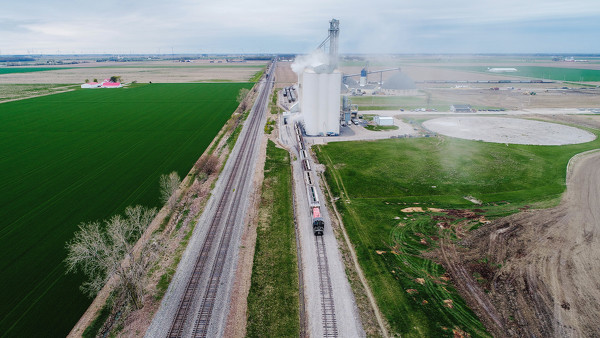
Mercer Landmark's Latty Terminal Grain Elevator sits on a Norfolk Southern mainline in Paulding County and can load full unit trains in a 15- to 24-hour window. A unit train consists of 85-90 rail cars that can transport around 320,000 bushels of grain.
Mercer Landmark acquired the Latty Terminal Grain Elevator in Paulding County in July 2020 and refurbished the facility. For the first time in more than 20 years, the grain elevator in May 2021 resumed loading full unit trains.
"That allows us to hit both the export markets on the East Coast and the Gulf, as well as the Southeast feed markets," Barnes said. "That really has opened up some marketplaces, and it allows us to increase prices to those producers in the norther tier of our territory."
Mercer Landmark's team of grain origination professionals assists farmers with implementing a grain marketing plan uniquely designed to their needs and circumstances.
"Producers are able to, again, sell at any point in time that they want, whether that's today or a sale into the future," Barnes said. "It's really our job to help them manage their risk in the best way that they can. … We've got a talented staff on board that really works every day to help them be successful and tries to do what they can to achieve the goals that the producer is looking for in their operation."
Grain origination professionals, Barnes said, take a host of factors into consideration when crafting a grain marketing plan, among them the cost of production. "A good day for us is when, obviously, we can help a producer sell their crops above their cost of production, lock-in a profit," he said. "Our whole focus is … to increase that producer's bottom line. Because if they remain profitable, then we still have a customer."
And that could mean recommending direct deliveries to facilities not owned by Mercer Landmark. "That's just making sure that we're doing what's right for the producer … how do we maximize his revenue," Barnes said.
Mercer Landmark, in association with FCC Futures Inc., also offers a full-service commodity brokerage service.
"The brokerage service is a just another way for producers to manage their risk," Barnes explained. "And so if they want to take a little bit more advanced approach and start to use futures and options independently of the contracts that we provide as a company, then obviously we want to be there to help (them) navigate that and provide that service and advice and all of those things that go along with (commodities trading)."
Mercer Landmark is on the cusp of producing 1 million tons a year of livestock feed, according to Barnes.
"I think what really sets us apart (in our feed business) is that our sales and service team is world-class," Barnes said. "Most of them actually raise livestock themselves, and so they are out there every day giving the advice and service that they would do on their own farm. … We've got people who are really treating the customer-sales relationship as a partnership."
Heartland Feed Services was established in April 2022 as a joint venture between Mercer Landmark and Sunrise Cooperative, according to Mercer Landmark's website. "As the area's top feed suppliers, we made the decision to combine our feed entities into a single operating feed company to better service and support producers in Ohio and Indiana," the website states.
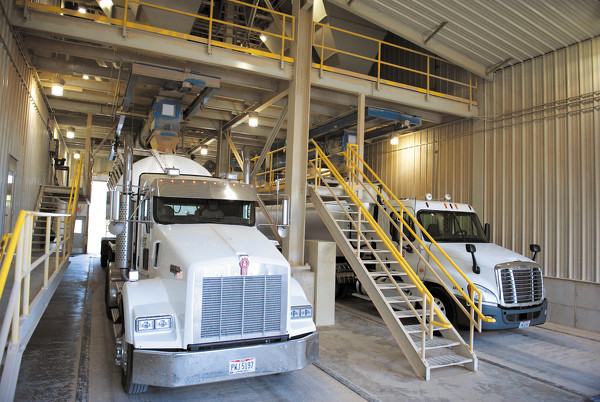
Trucks pull in to load up on poultry feed at MPS Feed Mill, a state-of-the-art facility in St. Henry, capable of producing five to six semi-loads of feed per hour.
MPS Feed, a $26 million, state-of-the-art, high-speed, high-volume feed mill and processing plant located at the intersection of Carthagena Road and State Route 118, opened mid-March 2020. It specializes in the efficient production of poultry feed for layers and pullets for customers throughout western Ohio and eastern Indiana, according to the website. The operation is a partnership between Mercer Landmark Inc. and Prairie Star Farms.
"We make poultry feed from start to finish, from taking corn in … grinding it down to the correct micron size and then putting all the ingredients together to make 24-ton loads of feed to take to all the poultry operations that we work with in the area," Mercer Landmark employee Kevin Kaup said a few years ago while leading a tour of the facility. With a maximum capacity of 1.5 million bushels of corn and two 10,000 bushel per hour grain pits, MPS Feed offers customers fast, efficient service. On average, the facility consumes 280,000 bushels of grain and deliver 535 loads of feed per week, according to the website.
When livestock production rises, so too does demand for feed. "Obviously we continue to expand livestock production in the area, especially Mercer County. The greater area continues to see livestock expansion. We had partners that were part of that livestock expansion when we went into building that mill. It's been a fantastic partnership," Barnes said.
Mercer Landmark offers several other lines of services, including a full range of agronomy products and services focused on adding value to farms. Among the offerings are crop protection, crop nutrient services and precision ag, which involves building a customized prescription based on a farm's zone or grid sampled soil data that maximizes crop nutrition investment.
The cooperative can even help assist farmers in making the best seed decision based on soil type, fertility, farming practices and yield goals. "I think that's one of the things that we continue to (focus) on is how do we make sure that we're making the proper investments as it relates to agronomy," Barnes said. "Those investments are really, really expensive, but we really want to be focused on how do we continue to provide the speed and space and the services and the products that our customers need, and how do we deliver that in a timely fashion."
The Mercer Landmark Energy Business Unit provides a variety of products and services for residential, farming, commercial, trucking and industrial customers, including propane, fuel and lubricants.
"It is a bit newer to the portfolio but really has been a great addition to the cooperative business," Barnes said. "We sell a lot of propane to livestock barns. Producers use a lot of diesel and lubricants, and so being able to be the provider of that to our customers has been great, and it also services the communities that we live in through residential propane and those types of things."
For farmers who don't have the time or equipment to move grain, the Mercer Landmark Logistics Business Unit can also handle hauling needs. The unit currently consists of 10 semitrailers equipped with GPS tracking systems, according to the Mercer Landmark website.
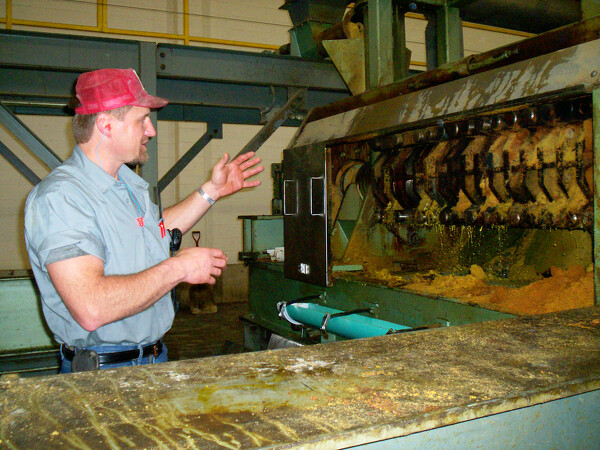
Dennis Schwieterman, plant manager at Mercer Landmark's soybean extrusion plant in Rockford, shows soybean oil dripping from machinery at the plant in this 2009 file photo.
Barnes attributes Mercer Landmark's success to a top-notch workforce. "The talent that we have within our organization is extraordinary, and they're very focused on how do we make the customer successful," he said.
And the cooperative is always on the hunt for prospective employees, especially those with ties to the area.
"We have a fairy robust internship program," Barnes noted. "We've got a great team on staff that really runs that, and they spend time every year hitting the Purdues and the Ohio States and the Wilmington colleges and all of those types of career fairs in the fall. We want the best students from each of those, and I think we're starting to see some traction in that we're getting a higher-quality candidate. Sometimes they're not always from here, (but) obviously we give preference to (local candidates) because if we can bring them back and they're already from the local area, that's great."
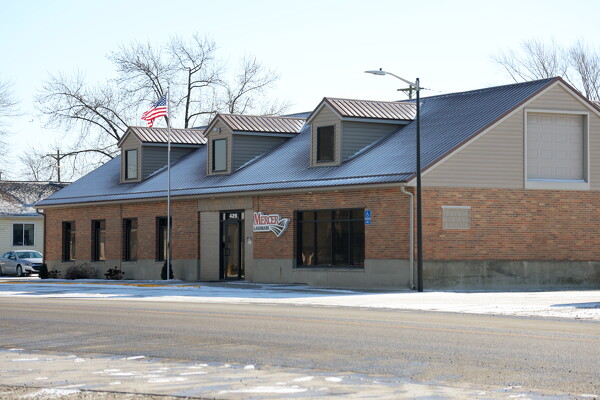
Mercer Landmark's Celina offices.
The grain market is tough for producers at the moment, but Barnes hopes prices will recover in the not-too-distant future.
"We're coming off of what I would say has been somewhat of a golden age since the early 2000s when grain markets really kind of took off. We've had some volatility over that period of time, and we've had some ups and downs, but generally speaking, markets had stayed at a place where producers could be fairly profitable," Barnes explained.
The cycle, though, has turned, and grain markets are currently yielding prices "under the cost of production." "We definitely have grain markets that are under profitable levels," Barnes said. "The question is: How long are we going to stay here and what changes from a world dynamic will help us boost that back?"
Such trying times underscore how crucial it is for Mercer Landmark to deliver high-quality services and solutions.
"Whether that's from an agronomy standpoint, crop inputs and trying to come up with the right recommendation to put out on a field, and even more importantly, how can our grain originators and grain merchandisers write marketing plans and marketing strategies to help these producers best take advantage of the market as it is given to us?" Barnes asked. "I think it really is a time where hopefully our producers will continue to lean on us - and hopefully we will see grain markets recover not too long (from now)."




